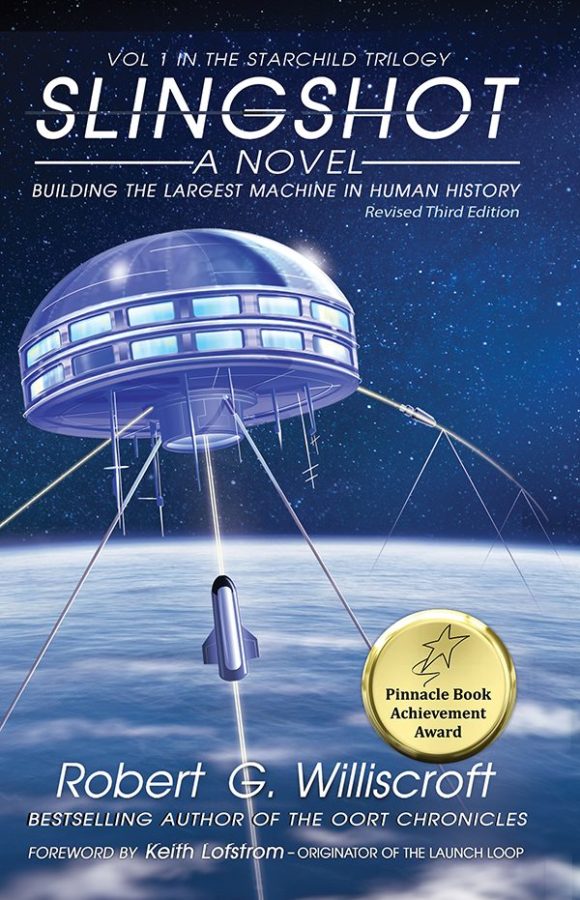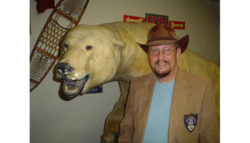The Starchild Trilogy Vol 1
by

- Slingshot: Building the largest Machine in Human History
- The Starchild Compact: A Novel of Interplanetary Exploration
- The Iapetus Federation: Exodus From Earth
- The Starchild Trilogy
Slingshot is a love story—about a man, a woman, another man, another woman, some gender bending…and a machine, the largest ever built.
Slingshot is a mystery—about a missing aviatrix, a conspiracy, a true-believer. Slingshot is an adventure—about following a dream, the ocean-deep, outer space.
Slingshot is about constructing the first space launch-loop stretching 2,600 km between Baker and Jarvis Islands in the Equatorial Pacific. It’s about high finance, intrigue, unlimited ambition, heroism, fanaticism, betrayal…and about opening space to the common person.
With a cast of 69, Slingshot takes you from Seattle’s world financial district, to the ocean bottom at 5,000 meters off Baker Island, to the edge of space 80 km above. You play with dolphins and battle sharks. You fly and sail and dive, you work and play and love across the vast panorama of an Equatorial Pacific being put to leash to serve humanity’s surge into outer space.
While its accurate science and precise engineering will appeal to hard science-fiction buffs, Slingshot’s major focus is the grand journey, the opening of outer space to the common person by men and women who loom larger than life as they work, play, and love.
Publisher: Starman Press
Illustrators:
Cover Artists:
Genres:
Tropes: Conspiracy, Enemy to Ally, Fellowship, Marooned, Person in Distress, Quest, Space Pilot, Training
Word Count: 119500
Setting: Earth, South Pacific, LEO
Languages Available: English
Series Type: Same Universe / Various Characters
Tropes: Conspiracy, Enemy to Ally, Fellowship, Marooned, Person in Distress, Quest, Space Pilot, Training
Word Count: 119500
Setting: Earth, South Pacific, LEO
Languages Available: English
Series Type: Same Universe / Various Characters
CHAPTER ONE
EQUATORIAL PACIFIC—SOUTHEAST OF BAKER ISLAND
Margo stopped kicking her feet as the ominous gray shapes flashed into her peripheral view. Long, tawny hair floated past her head as her feet dropped below her slim, brightly clad body. She took a deep breath and floated slightly upward. A hint of fear crept into her mind as she turned toward three gray, sleek predators cruising just inside the limit of her vision, about twenty-five meters away.
A gentle touch on her shoulder startled her. She turned to see Alex Regent tapping the depth reading on his dive console with his index finger. Margo reached down and grasped her console, turning it so she could read her depth: twenty-five meters. She had drifted upward five meters since seeing the sharks.
READ MOREMargo exhaled angrily and let some air out of her breathing bag. She knew better than to lose track of her depth. Out there, her life depended on a constant awareness of exactly how deep she was. Together she and Alex sank back to thirty meters. Off to their right, the three gray shapes drifted with them. Would she ever get used to it, she thought, as she released a bit of air into her bag to stop her descent.
“Alex,” she said.
There was no response.
“Alex!” She tapped the back of her console several times.
“Alex!” Nothing but silence.
Alex placed himself in front of Margo and looked into her face mask. With his right hand, he formed a circle with thumb and forefinger. His three other fingers extended straight up.
Margo returned the sign indicating she was all right while nodding vigorously. Then she pointed to her ear and lifted her console, tapping the back. Alex fumbled at his ear, then tapped his console, and then shook his head.
Great, Margo thought. EFCom is busted just when we really need it. Not busted, she corrected herself, just a submerged antenna. She pointed to the three menacing shapes off to her right. Alex turned and scanned around them. Above and just behind them, the blue-painted hull of their boat bobbed in the gentle waves. About twenty meters ahead of them hung a smooth, horizontal fluorescent orange tube about one meter in diameter. To the left, it stretched into the gloom; to the right, it angled downward. The fluorescent tube was attached to a slender cable angling up to the shadow of a buoy just beneath the surface to their right. Alex turned back toward Margo, making an exaggerated shrug.
Margo reached for her dive console again and pressed a button located prominently on its face. The three sharks turned and commenced a meandering movement toward the two divers. Their front fins extended stiffly downward at about forty-five degrees. Their backs arched slightly, and their blunt snouts moved back and forth as they approached.
Margo felt her hair stand up on the nape of her neck. She turned to Alex and motioned him to her side. Alex withdrew a telescoped baton from its holder at his waist and extended it to its full one-and-a-half-meter length. He checked the safety lever near its handle, and with his thumb he flicked the lever so it pointed forward. As the sharks drew nearer, he held the stick out in front of him, pointed in their direction. Margo glanced around them again and pushed her console button once more. Alex waved the stick about slowly, and then steadied up on the nearest of the three menacing monsters.
Suddenly, with blurring speed, the nearest shark attacked. Alex struck out with his stick, the jolt of its impact rocking him backward. A sharp crack was followed by a hissing sound as carbon dioxide rushed into the shark’s body. In the same moment, flashes of silvery-black streaked from several directions. One of the remaining sharks was struck broadside by a dolphin’s blunt nose. In a flash, it disappeared.
The animal Alex had injected rolled on its side and began a crazed, uncontrolled spiral toward the surface thirty meters above them. On its way up, it was hit several times by charging dolphins. It expired of massive embolisms before reaching fifteen meters. In the melee, the third shark vanished.
Margo reached out for Alex, grabbed a handful of breathing bag, and pulled him close to her. She placed the flat of her full-face mask against his and looked deeply into his eyes, as close to a kiss as she could come under the circumstances. Even down here, they were deep blue. Several bubbles escaped from the positive pressure maintained inside their masks and shimmered their way toward the surface, expanding rapidly as they rose.
Like an old-time scuba diver, Margo thought, watching the rising silvery spheres. Instinctively she checked the volume in her breathing bag and glanced at the gauge on her tiny, ultra-high-pressure air flask. She found she was holding her breath, and as she felt the need to breathe, a gentle pressure developed against her back. She pulled back and turned to confront a two-and-a-half-meter-long dolphin nudging her from behind.
It was one of four that had responded to her sonic signal—George, her favorite. The other three dolphins crowded in around the neoprene and nylon suited divers, jostling each other for attention. Margo rubbed the head dome of each and indicated to Alex that he should do the same. Then the two of them turned their attention back to the tube suspended in front of them.
Alex swam to the angled portion and began to search along the tube’s length, descending slowly. Margo dropped her arm from George’s neck and kicked in Alex’s direction, keeping him in sight, but staying between him and the surface. The four cetaceans arrowed toward the surface and grabbed a gulp of air, then settled back down, playfully cycling between Alex and Margo, gently jostling them. About thirty minutes later, Alex motioned Margo to join him. She released a bubble of air from her bag and dropped down beside him. Her console showed a depth of fifty meters. Alex pointed to a five-centimeter rip in the bottom curve of the tube’s fluorescent covering.
Margo reached into a deep pocket located on the left leg of her suit and withdrew a role of patching tape. Alex stretched the edges of the tear, and Margo applied a strip of self-sealing tape along the opening. Then she located a small pneumatic valve on the top of the tube and attached a hose from her spare air tank. On a signal from Alex, she released air into the tube, forcing water out through a one-way valve on the underside. She stopped when bubbles escaped from the lower valve.
As the tube rose slowly, Margo held on, keeping track of their progress on her console. They stopped rising when the gauge read thirty meters. Margo felt the tube—it was taut and solid. She tapped the back of her console, listening for the faint rush of sound in her ears. Nothing. She pointed to the back of her console and then her ear, and shook her head. Alex offered another of his exaggerated underwater shrugs and grinned, although the only part of the grin she could see was his crinkled eyes. She grinned back and pointed toward the suspension buoy and their boat, making an angled upward sign with her free hand. Alex nodded, checked his console, and they both headed back, slowly rising as they swam.
Margo saw Alex check his console from time to time, making certain they kept below the ever-changing ceiling limit it calculated for him. Since she had remained shallower than Alex for most of the dive, she knew she would be safe following his lead. She looked around at the four dolphins. Her earlier fright was gone, and she simply enjoyed George’s protective nearness and the playful bumps and nudges from the others.
On the surface finally, Alex dropped his face mask down around his neck, fully inflated his bag, and grinned at Margo. “Close call down there!”
Margo shoved her face mask down and patted the glistening snout that appeared in front of her. “Thanks, George. I love you too.”
The dolphin mewed a pleased response, lifted his body out of the water, and backed away, chattering as he went. The other three animals circled at and below the surface, keeping watch over their human charges.
“What happened to the EFCom?” Margo asked. “I expected it to come back online as soon as the antenna surfaced.”
“Broken antenna wire, I imagine,” Alex answered.
“Storm damage, I’m sure,” said Margo, as they turned and headed toward the waiting vessel.
“Probably,” agreed Alex. “But that wasn’t a burst seam,” he added.
“Yeah, maybe the sinking tube snapped the wire.”
Actually, tube flotation chambers flooded regularly. They had patched a full ten percent of them since the project started. But it was a bit unusual to find a rip on the tube bottom, and the Electrostatic Field Communication (“EFCom”) transceivers on the buoys almost always survived.
***
The EFCom buoy nearest the tear had ceased transmitting, and the buoys on either side of the tear had signaled their departure from datum a day earlier. Alex had opted to employ an electrostatic field communication system because of its clear underwater signal transmission capability that was independent of acoustic conditions since it didn’t rely on sound transmission through the water. Every buoy, each skimmer and floater, and every diver was outfitted with one of the small EFCom transceivers. Alex had inspected the non-transmitting buoy personally during an overflight from Jarvis Island. There was nothing visible on the two kilometers of surface between the buoys; they were closer together, but not so that it was visible to the eye. Nevertheless, the remaining 1,828-odd buoy-suspended kilometers of tube were stressing from the downward pull of the waterlogged section. The buoy near the tear was several meters underwater.
Suspended inside the flotation tube were two virtually impervious, lightweight, hose-like tubes, each about six centimeters in diameter, called vacuum sheaths. Two shallow channels jutted out from the bottom of each vacuum sheath, filled with electronically-controlled suspending magnets. Magnetically suspended inside each vacuum sheath was a five-centimeter tube of segmented soft iron officially called the rotor, but more popularly known as the ribbon, so named from the earliest conceptions back in the 1980s of the Launch Loop inventor, Keith Lofstrom. Alex was eager to check continuity readings to make certain the vacuum sheaths had not breached. They were not yet evacuated, but seawater entry at this stage would seriously delay the entire project. If the EFCom had not crapped out, the tests would already be underway.
Alex glanced ahead at Margo Jackson, cavorting with her four dolphins as they made their leisurely way back to the waiting boat. His field engineer in charge of underwater construction was a remarkable female. Nearly as tall as his own 183 centimeters, her model’s slender figure, encased in electric-blue nylon-covered neoprene, seemed to lack feminine curves. He knew differently, of course, having joined her bikini-clad person from time to time for morning swims since the project began over two years ago.
The project—Alex had lived with it for three years before actual construction began. Longer, actually, if you considered dreams—since before the incredible, worldwide bi-millennial celebration, when he still was a young boy.
There was the nearly simultaneous publication in America and England of practically identical ideas in 1985. Paul Birch published an article in The Journal of the British Interplanetary Society, while in America, Keith Lofstrom published his article in a supplement to The Journal of the Astronautical Sciences, he recalled. Nobody could agree on the names: Skyrail, Launch Loop, Beanstalk. There were others, but the idea is what counted, the sky-shaking idea that you don’t need rockets to get into space.
Newspapers were full of explanations three-and-a-half years ago when the aging president of a computer software giant made the announcement. He would funnel a significant portion of company profits into the consortium. Space travel would become as commonplace and inexpensive as the personal computers his pioneering work had made possible. He went on to outline the easy-to-understand concept.
Imagine a water hose streaming water in a parabolic arch. Deflect the water and funnel it back to the start through a pump, creating a closed system. Make the stream strong enough and the hose light enough, and the entire structure will support itself—the water holding up the hose structure. Now, replace the water with a thin, closed-loop pipe of segmented soft iron. Make it 5,000 kilometers around and accelerate it to orbital velocity with gigantic linear induction motors from two points on the equator 2,000 kilometers apart. The center section of the structure, including both the outgoing and return legs of the loop, will rise to about eighty kilometers above the Earth. Supply access to the upstream end in space with a Kevlar-hung elevator, and you can launch capsules by magnetically coupling them to the rapidly moving iron pipe.
Slingshot, they called it. The greatest engineering undertaking in the history of the world, they said.
As the on-scene project manager, Alex was responsible for getting the job done, on schedule, on budget. He was building a gossamer structure over 2,500 kilometers long, a frail spider web, completely invisible when viewed from more than a few kilometers. Alex grinned wryly. All Slingshot really consisted of was a fancy evacuated tube, a flexible iron pipe, four linear drivers and their power sources, some guy wires, and a couple of elevators. Put that way, it seemed simple enough. But, of course, it wasn’t simple at all, and for all his skill and engineering competence, and despite surface appearances, deep down, Alex was not entirely sure that he could make it happen.
Margo and Alex climbed up the ladder and onto Skimmer One’s bobbing fantail. This was one of two skimmers on the project—twelve-meter-long surface-effect boats that looked more like a floating aircraft than a traditional motorboat. They were capable of 200 knots, skimming about one-and-a-half meters over the wave tops. They had a small open fantail, just large enough for a couple of divers to doff their gear. Being on the fantail when the skimmer was on its cushion was more than dangerous, and was strictly prohibited throughout the project.
Alex signaled to the waiting coxswain, and they got underway for Baker, plowing through the water while Alex and Margo remained exposed. He and Margo stood near the stern railing and removed their dripping skins. Alex looked back at the buoys, now presumably in their proper places.
“How many more times?” Alex looked quizzically at Margo.
“Who knows?” She glanced back at the bobbing buoys. “We have repair people available at both ends. We shouldn’t be doing this ourselves, you know.” She turned and looked directly at Alex. “What do you think—weather or sabotage?”
Alex shrugged and tossed the spent carbon dioxide cartridge from his shark stick in the general direction of the cavorting dolphins. “I wanted to see for myself, and I still don’t know. Does it matter? We can’t patrol the entire eighteen-hundred-twenty-eight kilometer length anyway.”
“What are we dealing with?” Margo asked. “You don’t get out here in a rowboat.”
“We’re two thousand wet klicks from any kind of civilization,” Alex said. “At minimum, that’s a large motor-yacht or even an ocean sailer—you know, one of those we maybe can afford when this job is done.” He sighed. “We’re dealing with lots of money and someone with a major bitch.”
He looked into her green eyes.
“Just keep my tubes at depth.” His blue eyes flashed, and he turned toward the cockpit to radio his orders to test pipe continuity.
***
Margo dropped her eyes at his challenge. For the thousandth time, she asked herself if she had bitten off more than she could chew with this assignment. Was it her fault that the flotation chambers kept ripping? Was she missing something important? Was she copping out to imply there might have been sabotage? And yet, Alex seemed to agree that it might be sabotage. When she joined the project two years ago, the newspapers had acclaimed her as the ideal role model for the new twenty-first-century woman. At times that burden lay heavily on her shoulders, as it did now, she reflected.
It was a vast responsibility, and there was no way one person actually could control all of it at once. How Alex handled the weight of the entire project awed her, but she was careful never to let him know.
Margo watched Alex step into the cockpit. He was tall and slender, richly tanned from his constant outdoor work. She felt a softness well up inside her, a gentle warmth spreading out from the pit of her stomach. She bit her lower lip and turned angrily to lean on the after-railing.
None of that, she chided herself. This assignment was too important, and the stakes too high, to let any kind of emotion intrude. As she entered the cabin and sealed the port, the skipper switched modes, and pressurized air quickly filled the hard-sided skirt. In moments the skimmer lifted out of the water, except for the port and starboard skirts that protruded about a meter into the waves. Within seconds, high-pressure water nozzles jetted water from the end of each skirt, and within thirty seconds, Skimmer One was approaching 200 knots.
As Skimmer One headed into the afternoon sun, trailing an arrow-straight wake of white foam, Margo stood looking aft through the sealed port, remembering her instinctive sharing, and their underwater kiss following the fright of nearly becoming shark food. She shook off the sensation and busied herself with putting away their diving equipment. But a hint of a smile remained on her lips as they shot over the surface, finally settling back onto the water as they entered the small protected artificial harbor on the west side of Baker Island, just south of a shallow reef that went dry at low tide.
COLLAPSEProf. John B. Roseman, Norfolk State University, Former Chairman of the Board, Horror Writers Association, Author of The Inspector of the Cross Series. on Amazon reader review wrote:Real people, accurate science, and high adventure under the ocean, in the air, and in space. This is about the heroic men and women who will take us there, and the villains who try to stop them. Keith Lofstrom Inventor of the Launch Loop Slingshot does for the launch loop what Arthur C. Clarke's The Fountains of Paradise or Sheffield's Web Between the Worlds did for the space elevator. Again Williscroft delivers a great mix of hard science fiction and action. - Alastair Mayer Author of the Tspace Series The engineering triumph portrayed in this book is staggering - an electromagnetic loop 80 kilometers high able to launch spacecraft safely into orbit without rocket fuel. A dedicated team of visionaries overcomes natural hazards and sinister opponents to complete this heroic project. The detail is convincing, and the action is entertaining. John Knapman, PhD Director of Research International Space Elevator Consortium (ISEC) Robert Williscroft deftly crafts an energetic story around a phenomenal technological development just over the horizon: the space launch loop. The technical detail woven into this story is an education unto itself. But don't assume that Williscroft chooses raw infodump over story - Slingshot is an adventure that pulls you in, gives you characters that are engaging, and invites you to follow them through their challenges. What Williscroft has done in Slingshot is no easy task - he has balanced the hard aspect of science fiction with the character portrayals that those who despise that very hard science fiction beg for. The last decade has seen impressive leaps in the theoretical work toward the launch loop - this book couldn't come too soon! And you won't be able to keep from reading all the way to the end. Williscroft's art continues to be praise-worthy!
Kiltlifter on Amazon reader review wrote:Robert G. Williscroft states that Slingshot’s “ultimate function” is to provide an “economically viable” alternative to traditional rockets, which are expensive and wasteful. He presents an “inexpensive, routine” means of “transport into space from the Earth’s surface.” This launch loop, the largest machine ever built by man, is a “twenty-five hundred-kilometer-long doorway into space.” It originates in the ocean and features an eighty kilometer high skytower.
Williscroft takes care to describe in precise, scientific detail the engineering and composition of this huge device and to explain exactly how it moves and functions. Is he successful? Speaking personally, I absolutely came to believe the launch loop existed and stretched from Baker to Jarvis islands in the equatorial Pacific. When men boarded the capsule for the five-minute whiz trip to the top of the skytower, I rode with them, and when the author described each step High-Iron workers took in building the tower, I was part of the crew.
While the launch loop is the center of this novel, Slingshot is about a great deal more. It begins with the haunting, mythic mystery of Amelia Earhart and ends . . . well, let’s just say the ending is one of the most powerful and moving I’ve ever read. There’s also high finance, intrigue, and a conspiracy or two against Slingshot. Dolphins and deadly sharks play and attack, and we have romance and sex and more romance and sex. There’s adventure, heroism, and the striving to achieve humanity’s great dream of reaching the stars. And let’s not forget a cast (count them!) of 69, not to mention incidental personnel. All in all, it’s a sweeping, complex canvas which stretches from the equatorial Pacific to Seattle to elsewhere.
This is a wonderful, awe-inspiring novel that establishes the foundation for the rest of the series. I look forward to reading the sequel, The Starchild Compact, which I have just purchased.
John Knapman, PhD Director of Research International Space Elevator Consortium (ISEC) on Amazon editorial review wrote:Slingshot is an interesting read.
The story very much put me in the mindset of Neal Stephenson as there is a front-and-center technological innovation and it is shaping the lives of those who work around it. In the case of Slingshot, it is the eponymous invention which will help mankind reach orbit quickly and cheaply and shape humanity’s development beyond an Earth-bound society.
But the people of Earth have to build the thing first, and therein lies the drama.One of Slingshot’s strengths is its descriptions of the hardware. The innovations here are presented as plausible and the engineering feats are engaging. The technical jargon is never overbearing nor are there dry infodumps.
There’s also a big imagination at work here, too, but I’ll defer to those much smarter than me to know how much of what’s presented falls within the realms of possibilities. For the purpose of this hard scifi novel, nothing I encountered gave me pause.
Engaging story and it was the big picture of whether the characters would succeed that kept me turning the pages.
The engineering triumph portrayed in this book is staggering - an electromagnetic loop 80 kilometers high able to launch spacecraft safely into orbit without rocket fuel. A dedicated team of visionaries overcomes natural hazards and sinister opponents to complete this heroic project. The detail is convincing, and the action is entertaining.







